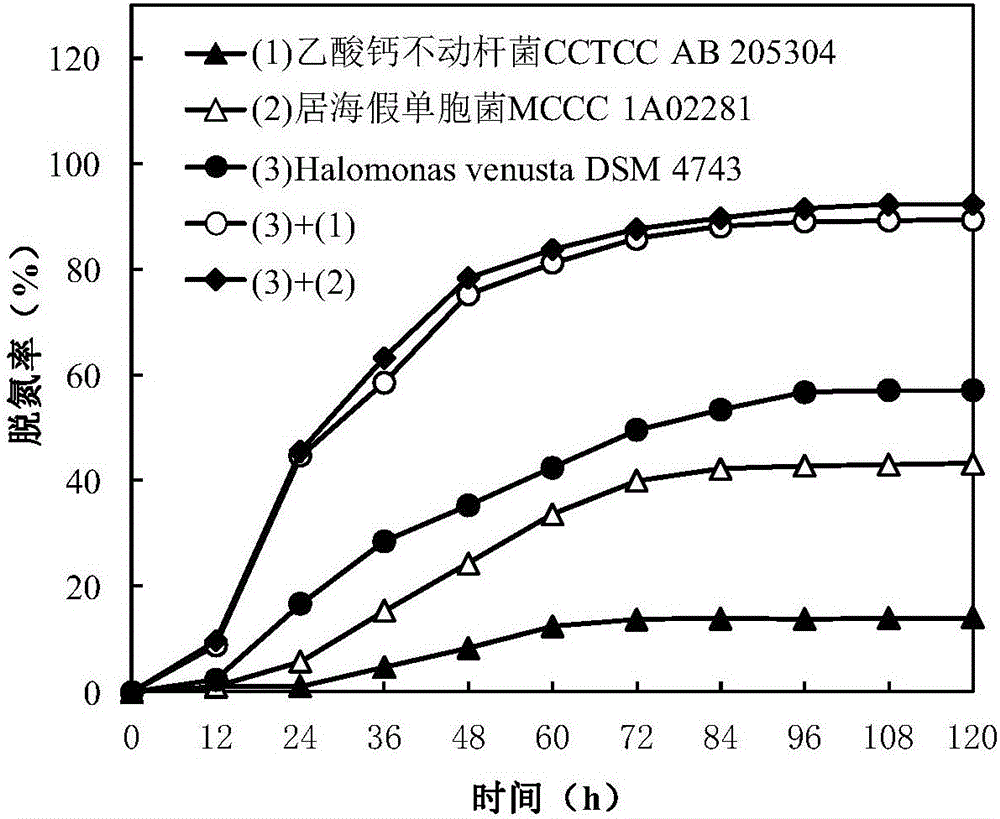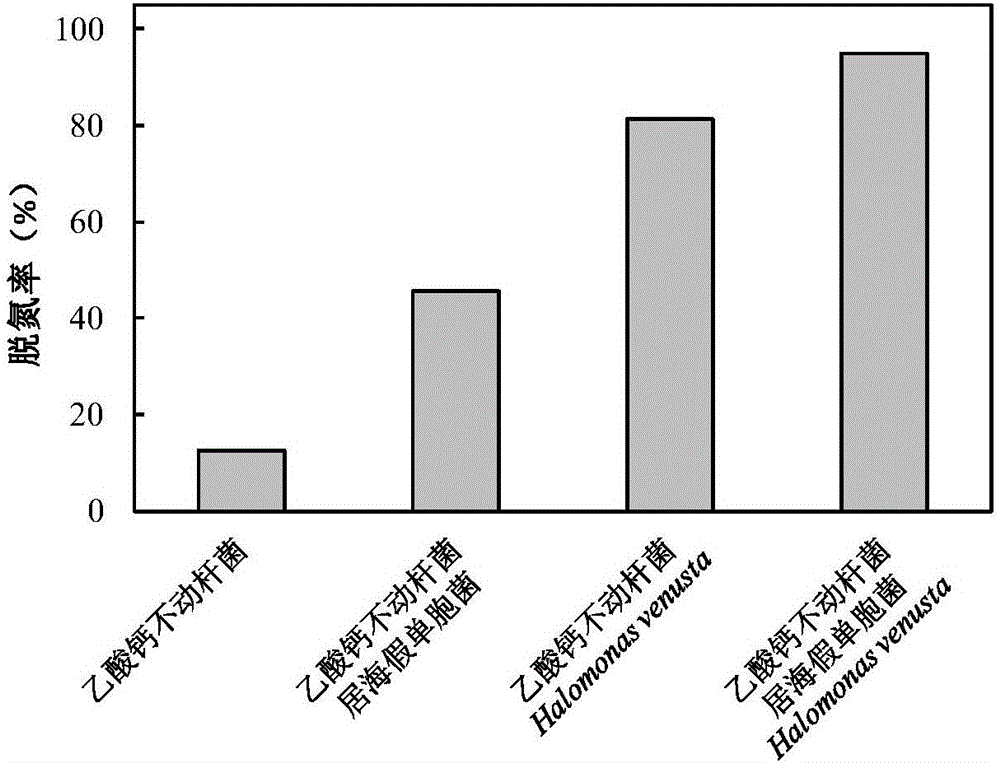High-salinity nitrogen-containing wastewater stress resistance auxiliary nitrogen removal method
A wastewater and denitrification technology, applied in the field of microbial denitrification, can solve the problems of low denitrification efficiency and achieve broad application prospects
- Summary
- Abstract
- Description
- Claims
- Application Information
AI Technical Summary
Problems solved by technology
Method used
Image
Examples
Embodiment 1
[0033] Example 1 Synthesis and secretion experiment of Halomonas venusta DSM 4743 ectoine
[0034] Strain: Halomonas venusta DSM 4743
[0035] Strain activation: Medium A, 30°C, 120r / min, 24h.
[0036] Ectrahydropyrimidine induction culture: Inoculate the above-mentioned activated bacterial solution into medium B (30mL / 300mL) at an inoculation amount of 1%, at 30°C, 120r / min, for 48h.
[0037] Determination of ectoine concentration:
[0038] Intracellular ectoine: Take 1 mL of fermentation broth, centrifuge (4°C, 14000×g, 15 min), add 1 mL of 80% ethanol (v / v) to the pellet to resuspend, and let stand at room temperature overnight. The suspension was centrifuged again, and the supernatant was taken for HPLC determination.
[0039] Extracellular ectoine: Take 1 mL of fermentation broth, centrifuge (4°C, 14000×g, centrifuge for 15 min), take the supernatant, dilute 10 times with deionized water, and use it for HPLC determination.
[0040] The total concentration of ectoine i...
Embodiment 2
[0044] Example 2 Acinetobacter calcium acetate CCTCC AB 205304 and Pseudomonas maritima MCCC 1A02281 absorb ectoine experiment
[0045] In order to examine whether the SND denitrification strain Acinetobacter calcoaceticus CCTCC AB 205304 and Pseudomonas maritima MCCC1A02281 can absorb ectoine, the following experiments were carried out.
[0046] Strains: Acinetobacter calcoaceticus CCTCC AB 205304, Pseudomonas maritima MCCC 1A02281.
[0047] Strain activation: medium A (adjust NaCl concentration to 5g / L), 30°C, 120r / min, 24h.
[0048] Cell culture: Inoculate the above-mentioned activated strains into medium A (adjust the NaCl concentration to 5 g / L) at 1% inoculation amount, culture at 30° C., 120 r / min, for 48 hours.
[0049] Absorption of ectoine: Centrifuge the cell culture medium at 14000×g at 4°C for 15 min, discard the supernatant, and wash the cells twice with NaCl-KpiBuffer (100 mM, pH 7.2, NaCl 5 g / L). Then the thallus was transferred to 30mL NaCl-Kpi Buffer (100mM...
Embodiment 3 4
[0052] Example 3 Stress-resistance assisting experiment of ectoine-secreting strains on growth of SND denitrification strains at different salt concentrations
[0053] The ectoine-secreting strain (Halomonas venusta DSM 4743) and the SND denitrification strain (Acinetobacter calcoaceticus CCTCC AB 205304 and Pseudomonas marinum MCCC 1A02281) were mixed and cultured (containing 0, 15, 30, 45 , 60, 75, 90g / L NaCl medium C). In this combined culture system, the strain Halomonas venusta DSM4743 synthesized and secreted ectoine under the induction of NaCl, while Acinetobacter calcoaceticus CCTCC AB 205304 and Pseudomonas maritimus MCCC 1A02281 absorbed and secreted ectoine into the culture, and obtained Stress resistance, salt-tolerant growth. In the control experiment of salt-tolerant growth, the SND denitrification strain or the ectoine-secreting strain were cultured alone.
[0054] Strains: Halomonas venusta DSM 4743, Acinetobacter calcoaceticus CCTCC AB 205304, Pseudomonas ma...
PUM
 Login to View More
Login to View More Abstract
Description
Claims
Application Information
 Login to View More
Login to View More - R&D
- Intellectual Property
- Life Sciences
- Materials
- Tech Scout
- Unparalleled Data Quality
- Higher Quality Content
- 60% Fewer Hallucinations
Browse by: Latest US Patents, China's latest patents, Technical Efficacy Thesaurus, Application Domain, Technology Topic, Popular Technical Reports.
© 2025 PatSnap. All rights reserved.Legal|Privacy policy|Modern Slavery Act Transparency Statement|Sitemap|About US| Contact US: help@patsnap.com



